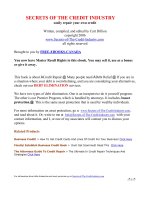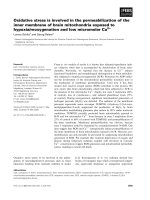Trading secrets of the inner circle andrew goodwin
Bạn đang xem bản rút gọn của tài liệu. Xem và tải ngay bản đầy đủ của tài liệu tại đây (6.06 MB, 96 trang )
Chapter 1
Market Wizard Filter
This chapter will detail a sophisticated method using interest rate and market breadth
models to filter a simple S&P oscillator system. This use of intermarket data can be very
useful in your timing operations if used judiciously. In fact, one S&P trader, profiled in
Schwager's "Market Wizards" uses a version of the filter I am giving you to assist in his
highly profitable trading operations.
First things first:
Basic Method of calculating the RSI index:
The formula for RSI:
RSI =100-(100/1+RS)
Where
RS= Average of x day's up close to close changes/average of x day's
down close to close changes.
For 8 day RSI you will be averaging the close to close changes of the last 8 up days.
Then you will divide this figure by the average close to close changes of the last 8
down days.
Market Wizard Filter
11
dealing with a poor system is a W/L ratio worse than the .70 and intraday drawdown
nearly half as large as the net profit.
Why the basic 8 day RSI system fails:
By themselves, oscillator systems are extremely dangerous if used in the traditional way.
Buying when an oscillator such as stochastics or RSI turns up from oversold can bankrupt you during a landslide decline. Nothing in the oscillator system will provide you
with an exit from your trade except a turndown from the overbought area by the oscillator. If the oscillator goes down after your buy and does rally enough to make the oscillator go above the sell line, you may lose a tremendous sum.
Filtered 8 day RSI system:
The process of transforming the 8 day RSI system from lemon into a gem involves filtering with internal and intermarket models. What we will do is tell the system that it may
only enter into the stock index futures contracts when conditions for an advance are
most favorable. Furthermore, if the conditions that led us to enter the market deteriorate, then we build in a mechanism for exiting the trade. We can exit before RSI crosses
below the sell line when danger approaches. Now I will give you two ways to do this
including the "Market Wizard" method.
Market Breadth Filtered 8 day RSI:
Rules:
1) Calculate the 10 day simple moving average of the number of advancing issues on
the NYSE. This number is available from most quote services, brokers and financial television tickers. A ten day moving average is calculated by adding the last
ten days of advances and dividing this sum by 10.
2) Calculate the 10 day simple moving average of the number of declining issues on
the NYSE. Follow the same procedure that you did to calculate the 10 day moving average of advances.
12
Trading Secrets of the Inner Circle
3) Divide the 10 day average of advances by the 10 day average of declines.
4) If the value of the division is greater than .75 or 75% then our market breadth filter
is considered positive.
5) If the value of the division is less than .50 then our market breadth filter is considered negative.
6) If the breadth filter is positive then buy the S&P 500 contracts on the close of the
day when the 8 day RSI crosses from below to above 30.
7) Exit your long position if the 8 day RSI crosses from above to below 65.
8) Also exit your long position if the market breadth filter changes from positive to
negative.
Results and discussion of the Breadth Filtered 8 day RSI
This system adds a trend filter designed to get us out of the trade if market breadth
deteriorates while we are in the trade, but the 8 day RSI fails to provide us with an exit.
This technological advance allows us to get out of bad trades more quickly than we
would if we were trading the 8 day RSI system. Profit factor rises to 4.55 from the 3.29
of the basic system. Our net profit increases by $28,000 and our maximum drawdown
shrinks by nearly 65%. This system clearly improves the result of the basic system and
gives us a safer way to trade. However, the W/L ratio is still too low at .71. So let us
move to the "Market Wizard" version.
Treasury Note and Treasury Bill Filtered 8 day RSI:
These filters were adapted from a concept discussed by the great S&P trader, Marly
Schwartz who was interviewed in the trading book "Market Wizards." Schwartz suggests trading S&P futures when both bonds and short paper are above their moving
averages. This model draws on Schwartz's concept, but we have added our own twist.
Market Wizard Filter
13
Rules:
1) Each Friday, record the close of the CBOT's ten-year note future. When the
Friday close of the ten-year note is greater than its 40 week moving average then
the note filter is positive. If Friday is a holiday, use whatever close is the last close
of the trading week.
2) Each Friday, record the close of the Treasury bill future. When Friday's closing
T'bill future price is greater than its 40 week moving average, then the short paper
filter is positive.
3) If the note filter and the bill filter are both positive then the interest rate component
is positive.
4) If the note filter and the bill filter are both negative then the interest rate composite
is negative.
5) If either the note filter or the bill filter is positive while the other is negative, the
last reading of the interest rate composite stays the same. A change in the reading
is only possible if both the note and the bill filter are above or below their moving
averages simultaneously at Friday's close.
6) If the interest rate composite is bullish, buy on the close of the day when the 8 day
RSI crosses from below to above the 40 buy line.
7) Exit your long trade if the 8 day RSI crosses from above to below the 75 sell line.
8) Exit your long trade if the interest rate composite changes from positive to negative even if RSI has not given an exit signal yet.
Discussion and Results of Market Wizard RSI system:
This version of the 8 day RSI system permits us to trade only when monetary conditions are favorable for stocks. When both short interest rates and intermediate interest
14
Trading Secrets of the Inner Circle
rates are declining, the monetary environment should normally be favorable for stocks,
We only will trade the S&P futures when we have the interest rate climate on our side.
Notice how with such an excellent filter as positive monetary conditions, we can change
our RSI parameters to make buying easier and selling harder. This allows us to capture
more dollars during favorable periods while avoiding risk when the monetary climate is
stacked against us. In fact over $200,000 in profits have been collected with this trade.
If the bill and note markets deteriorate while we are in a trade, we simply exit the trade
and wait for the next signal. This system has one of the best track records of any S&P
oscillator system that you are likely to see. With an 8.19 profit factor, 82% accuracy, and
a largest losing trade of less than $7,700, we have a great system. Add in the fact that the
system sports a 1.82 W/L ratio and you have the ingredients of a true "Market Wizard"
model.
Market Wizard Filter
15
16
Trading Secrets of the Inner Circle
Market Wizard Filter
17
18
Trading Secrets of the Inner Circle
Page 1
Type
Name
Notes
: System
: Chapter1 Basic 8 day
:
Last Update : 08/26/97 03:24pm
Printed on : 08/26/97 03:27pm
Verified
: YES
If rsi(close,8) crosses above 30 then buy on close;
if rsi(close,8) crosses below 65 then exitlong on close;
(Basic 8 Day RSI System Code)
Market Wizard Filter
19
20
Trading Secrets of the Inner Circle
Market Wizard Filter
21
22
Trading Secrets of the Inner Circle
Page 1
Type
Name
Notes
System
Chapter1
Last Update
Printed on
Verified
A/D Filter
08/26/97 03:16pm
08/26/97 03:18pm
YES
vars: adv(O), dec(O), quotient(0);
adv=average(close,10) of data2;
dec=average(close,10) of data3;
quotient=adv/dec;
if quotient>.75 then conditionl=true;
if quotient<.50 then conditionl=false;
if conditionl=true and rsi(close,8) crosses above 30 then buy on close;
if rsi(close,8) crosses below 65 then exitlong on close;
if conditionl=false then exitlong on close;
Printed using TradeStation PowerEditor by Omega Research Version 4.02.17 - Oct 02 1996
Market Wizard Filter
23
24
Trading Secrets of the Inner Circle
Market Wizard Filter
Chapterl Wizard
Date
Time
03/03/97
03/21/97
25
CCSP99A-Daily
04/02/82 - 04/04/97
Type Cnts
Price Signal Name
Entry P/L Cumulative
Buy
1
751.150
LExit 1
740.100
$ -5600.00 $ 200170.00
26
Trading Secrets of the Inner Circle
Page 1
_______
Type
Name
Notes
System
Chapter1 Wizard
Last Update
Printed on
Verified
08/26/97 03:39pm
08/26/97 03:47pm
YES
if close of data2>average(close,40) of data2 and close of data3>average(close,40) of data3
and rsi(close,8) crosses above 40 then buy on close;
if rsi(close,8) crosses below 75 then exitlong on close;
if close of data2
Printed using TradeStation PowerEditor by Omega Research Version 4.02.17 - Oct 02 1996
Chapter 2
The VIX Index Timing Model
Volatility represents one of the key elements in the pricing of stock index options. Implied volatility represents the options market's consensus opinion of future annualized
change in an underlying vehicle. The VIX index, tracked by the CBOE, measures the
implied volatility of a series of "at the money" OEX index options. Typically the VIX
will range between 10% and 20%. The higher the VIX index, the more expensive option
prices are due to volatility.
In developing your OEX trading strategies, you should take into account the level of
implied volatility as measured by the VIX. Ideally, you should be selling options when
implied volatility is high and about to fall. By the same token, you should attempt to buy
options when implied volatility is low and about to rise.
The VIX model that I am about to share with you is designed to give you a small advantage in figuring out the direction of implied volatility. The model has excelled at catching
2-3 point moves in the VIX on the long and the short side. In fact, the model has had a
perfect track record using only very simple rules.
You cannot go and trade the VIX index since no vehicle exists that isolates option implied volatility. In fact, I tried to price custom derivative options on the VIX with five
major Wall Street equity derivatives departments and each refused to be my counterparty
28
Trading Secret s of the Inner Circle
on the trades. Therefore, rather than trade the VIX, you should incorporate the VIX
model into your option strategies as noted.
Track records referred to in this chapter can be found on pages 29-32.
Rules of the VIX model: (Test period 5/93-8/97)
1) Sell VIX index at the close if it rises 2 points (i.e. from 15 to 17) above its 40 day
moving average.
2) Exit short VIX index on close if the index falls more than 2 points below your
short entry level and the VIX is less than 2 points above its 40 day moving average.
3) Buy VIX index at the close if it falls 2 points (i.e. from 11 to 9) below its 40 day
moving average.
4) Exit long VIX index on close if it rises more than 2 points above your long entry
level and the VIX is greater than its 40 day moving average minus 2 points.
Results and discussion:
The VIX model gave 37 signals. Every signal but one, eventually showed a gain. The
average trade resulted in a pickup of 2.93 points on the VIX. Of course, the model does
not capture the exact turning point in implied volatility. At times, markets have moved
against positions for a number of sessions.
Wall Street has hired a bevy of scientists to predict implied volatility. However, by simply
recognizing that the VIX index has a distinct tendency to revert to mean values, we
should be able to make our options trading more efficient. Also note that short positions
initiated by the model on the VIX last fewer days than longs. This may be due to a
tendency for market volatility to rise less rapidly than it falls. The shorts have generated
more rapid exits.
The VIX Index Timing Model
29
30
Trading Secret s of the Inner Circle
The VIX Index Timing Model
31
32
Trading Secrets of the Inner Circle
Page 1
__________
Type
Name
Notes
System
Vix System
Last Update
Printed on
Verified
08/26/97 04:12pm
08/26/97 04:17pm
NO
if close>average(close, 40) +2.00 then sell on close;
if close
if close
then exitlong on close;
Printed using TradeStation PowerEditor by Omega Research Version 4.02.17 - Oct 02 1996
Chapter 3
Crash Filters For The Stock
Market
This chapter will be short and sweet. Though the topic may seem a bit unusual, it may
end up being the most important chapter in the book for many of you. The information
contained is crucial. Indeed, recognizing the pattern I will show you may very well end
up saving your career as a trader. It may also make your career as a trader if the pattern
unfolds, and you take aggressive positions for a smash. In fact, in 1994, this model gave
a signal that I relayed to my fund manager. He took immediate action in the OEX Put
market and saved the fund millions of dollars over the next month. The subject of this
report is panic liquidation of the stock market, when it has happened, how to predict it,
and how to profit from it.
My crash filter pattern does not get tripped too often. Usually the market goes up. In
fact, on only 235 days has the trade called for a short position in the market since 1986.
Even when the pattern does occur, there have been times when no panic liquidation has
taken place. Do not panic yourself when the pattern appears imminent. No market move
can be called inevitable. However, taking protective measures with your money and
making a speculation in put options seem warranted.
Many commentators have theorized that drops in the price of Treasury instruments such
as bonds, notes or bills can be very negative for stocks. Similarly, other researchers have
found a link between the U.S. dollar's price momentum and stock prices. A falling dollar









